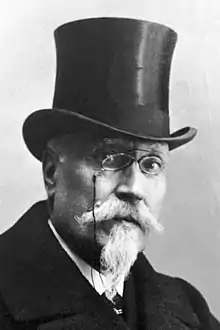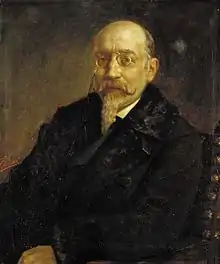José Echegaray
José Echegaray y Eizaguirre (19 April 1832 – 14 September 1916)[1] was a Spanish civil engineer, mathematician, statesman, and one of the leading Spanish dramatists of the last quarter of the 19th century. He was awarded the 1904 Nobel Prize in Literature "in recognition of the numerous and brilliant compositions which, in an individual and original manner, have revived the great traditions of the Spanish drama".
José Echegaray | |
|---|---|
 | |
| Born | José Echegaray y Eizaguirre 19 April 1832 Madrid, Spain |
| Died | 14 September 1916 (aged 84) Madrid, Spain |
| Resting place | Saint Isidore Cemetery |
| Occupation | Dramatist, civil engineer and mathematician |
| Nationality | Spanish |
| Genre | Drama |
| Notable awards | Nobel Prize in Literature 1904 |
| Seat e of the Real Academia Española | |
| In office 20 May 1894 – 14 September 1916 | |
| Preceded by | Ramón de Mesonero Romanos |
| Succeeded by | Julio Burell y Cuéllar[lower-alpha 1] |
Early life
He was born in Madrid on 19 April 1832.[2] His father, a doctor and institute professor of Greek,[3] was from Aragon and his mother was from Navarra. He spent his childhood in Murcia, where he finished his elementary school education. It was there, at the Murcia Institute, where he first gained his love for mathematics. While still a child he read Goethe, Homer, and Balzac, readings that alternated with those of mathematicians like Gauss, Legendre, and Lagrange.
In order to earn enough money to attend the Escuela Técnica Superior de Ingeniería de Caminos, Canales y Puertos (Engineering School of Roads, Channels and Ports), he moved at the age of fourteen to Madrid.[4] At the age of twenty, he left the Madrid School with a Civil Engineering degree, which he had obtained as first in his class, and he had to move to Almeria and Granada to begin working at his first job.[5]
Professor and scientist
In 1854 he began teaching a class at the Engineering School, working as a secretary there also. He taught mathematics, stereotomy, hydraulics, descriptive geometry, and differential and physical calculus from that year until 1868. From 1858 to 1860 he was also a professor at the Assistants' School of Public Works.
His Problemas de geometría analítica (1865) and Teorías modernas de la física. Unidad de las fuerzas materiales (1867) were held in some regard. He became a member of the Society of Political Economy, helped to found the magazine La Revista, and took a prominent part in propagating free trade doctrines in the press and on the platform.[5]
He was clearly marked out for office, and when the revolution of 1868 overthrew the monarchy, he resigned his post for a place in the revolutionary cabinet.[5]
Government service
Echegaray also entered politics later in his life. As a founding member of the republican Radical Democratic Party,[6] he enjoyed a career in the government sector, being appointed Minister of Education, of Public Works and Finance Minister successively between 1867 and 1874.[3] He retired from politics after the Bourbon restoration in 1874.[5]
Literary career
Theater had always been the love of José Echegaray's life. Although he had written earlier plays (La Hija natural and La Última Noche, both in 1867), he truly became a dramatist in 1874.[5] His plays reflected his sense of duty, which had made him famous during his time in the governmental offices. Dilemmas centered on duty and morality are the motif of his plays. He replicated the achievements of his predecessors of the Spanish Golden Age, remaining a prolific playwright.
His most famous play is El gran Galeoto, a drama written in the grand nineteenth century manner of melodrama. It is about the poisonous effect that unfounded gossip has on a middle-aged man's happiness. Echegaray filled it with elaborate stage instructions that illuminate what we would now consider a hammy style of acting popular in the 19th century. Paramount Pictures filmed it as a silent with the title changed to The World and His Wife, and it was the basis for a later film The Great Galeoto. His most remarkable plays are O locura o santidad (Saint or Madman?, 1877); Mariana (1892); El estigma (1895); La duda, 1898; and El loco Dios (God, the fool, 1900).
Among his other famous plays are La esposa del vengador (1874) (The Avenger's Wife); En el puño de la espada (1875) (In the Sword's Handle); En el pilar y en la cruz (1878) (On the Stake and on the Cross); and Conflicto entre dos deberes (1882) (Conflict of Two Duties).[3]
Along with the Provençal poet Frédéric Mistral, he was awarded the Nobel Prize for Literature in 1904, after having been nominated that year by a member of the Royal Spanish Academy, making him the first Spaniard to win the prize.[7]

José Echegaray maintained constant activity until his death on 14 September 1916 in Madrid.[2] His extensive work did not stop growing in his old age: in the final stage of his life he wrote 25 or 30 mathematical physics volumes. At the age of 83 he commented:
I cannot die, because if I am going to write my mathematical physics encyclopedia, I need at least 25 more years.
Honors
Several streets in Spain are named after José Echegaray. Calle Echegaray in Madrid's Barrio de las Letras is especially noteworthy.[8][9] In 1971 the Bank of Spain issued a 1000-peseta banknote in his honor.[10]
Notes
- Burell was elected for the position in 1916 but never took the seat
References
- "José Echegaray y Eizaguirre - Spanish dramatist". Britannica.com. Retrieved 9 June 2018.
- Sánchez Ron, José Manuel (30 December 2004). "José Echegaray: entre la ciencia, el teatro y la política". Arbor (in Spanish). CLXXIX (707/708): 601–688. doi:10.3989/arbor.2004.i707/708.510. ISSN 1988-303X.
- "The Nobel Prize in Literature 1904:Frédéric Mistral, José Echegaray". Elsevier Publishing Company. Retrieved 7 February 2013.
- "Alicia Delibes – José Echegaray". Libertad Digital. Retrieved 3 December 2016.
- Fitzmaurice-Kelly 1911, p. 870.
- Gómez-Mendoza, Josefina. "José Echegaray, un liberal radical en Fomento".
{{cite journal}}: Cite journal requires|journal=(help) - "Nomination Database". Nobelprize.org. Retrieved 9 June 2018.
- Nuevo Vialás, Mar (26 August 2022). "Echegaray: La calle de Madrid que se cuela entre las más 'cool' del mundo". Tendencias Hoy, Economía Digital (in Spanish).
- "The best of the barrios: Barrio de las Letras". Things to Do, Madrid, Time Out (timeout.com). 13 April 2014.
- Mira Pérez, Jorge (2000). "Echegaray—Fiscal Scientist and More". Physics Today. 53 (6): 76–77. Bibcode:2000PhT....53f..76P. doi:10.1063/1.1306382. hdl:10347/18452.
- This article incorporates text from a publication now in the public domain: Fitzmaurice-Kelly, James (1911). "Echegaray y Eizaguirre, José". In Chisholm, Hugh (ed.). Encyclopædia Britannica. Vol. 8 (11th ed.). Cambridge University Press. pp. 870–871.
External links
- José Echegaray on Nobelprize.org with the prize motivation
- Elsevier Publishing Co. biography
- Works by José Echegaray at Project Gutenberg
- List of works
- Works by or about José Echegaray at Internet Archive
- Works by José Echegaray at LibriVox (public domain audiobooks)

- Newspaper clippings about José Echegaray in the 20th Century Press Archives of the ZBW